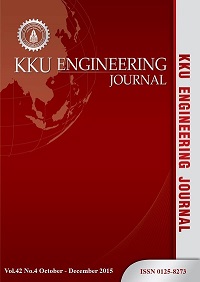Adsorption of anionic, cationic and disperse dyes with activated pyrolytic tire char
Main Article Content
Abstract
Activated pyrolytic tire char was applied as adsorbents to remove dyes from contaminated water. The method of surface treatment with ethanol solution, HCl solution and then activation with NaOH solution was proposed. After activation at 750oC, the specific surface area (SSA) of activated char (AC) increased from 154.7 m2/g to 228.9 m2/g. The pore size increased slightly from 323.4 oA to 349.3 oA and iodine number increased from 95 mg/g to 137 mg/g. AC was then utilized in the adsorption of three dyes which were acid dye (AR131), basic dye (BR18) and disperse dye (DR167) in a shaker with a speed of 75 rpm at 26oC. The initial concentration was varied to be 10 – 50 mg/L. The kinetic results were more consistent with pseudo-second-order model. Considering the adsorption rate constant, k2, it was found that kinetics for acid dye (AR131) was slower than basic dye (BR18) while kinetics for disperse dye (DR167) did not follow specific pattern since it cannot be dispersed well in water without any dispersing agent. Regarding adsorption equilibrium when the initial concentration was between 10-50 mg/L, the adsorption percentages for acid dye (AR131), basic dye (BR18) and disperse dye (DR167) were 88.2 - 100%, 100%, and 26.9 – 50.7%, respectively. In addition, the adsorption isotherms for acid dye (AR131) and basic dye (BR18) followed the Langmuir equation, whereas, that for disperse dye (DR167) was better fit with the Freundlich equation.
Article Details
This work is licensed under a Creative Commons Attribution-NonCommercial-NoDerivatives 4.0 International License.



